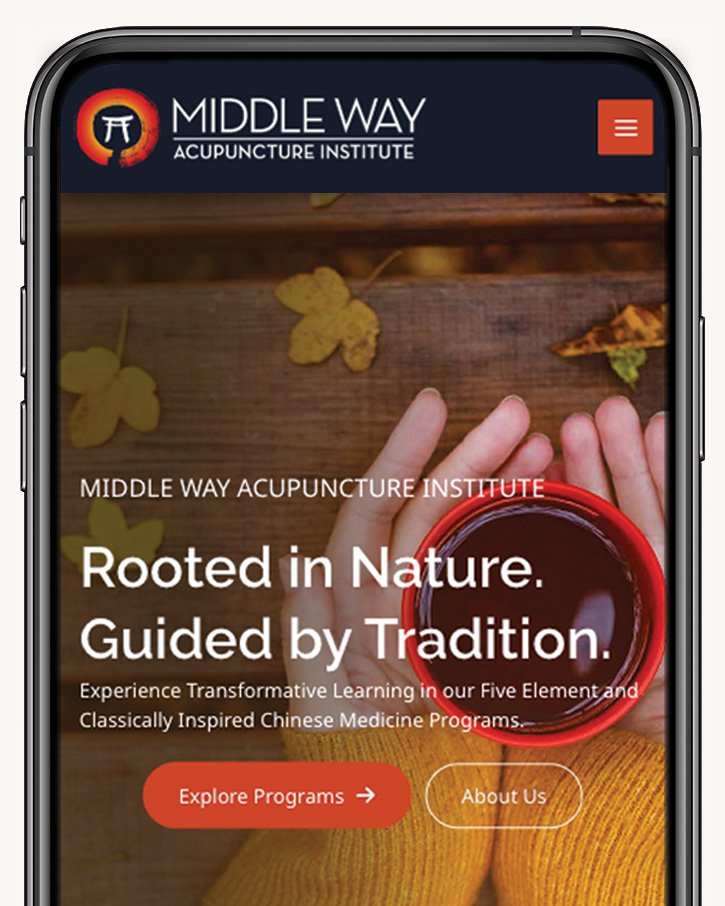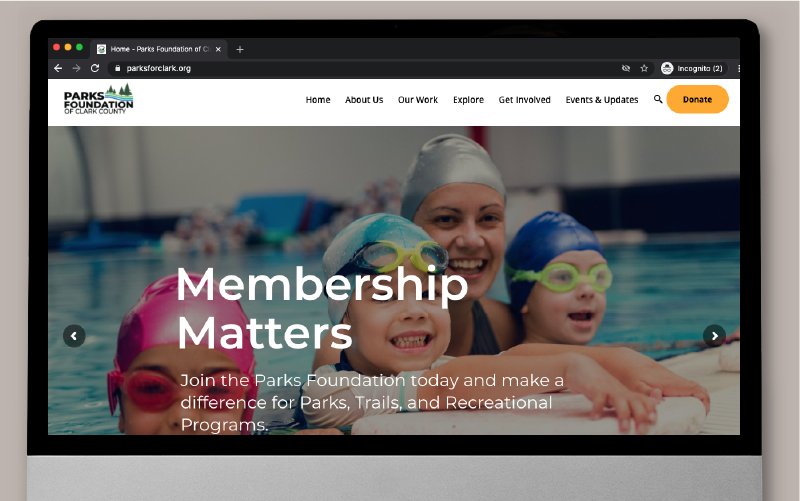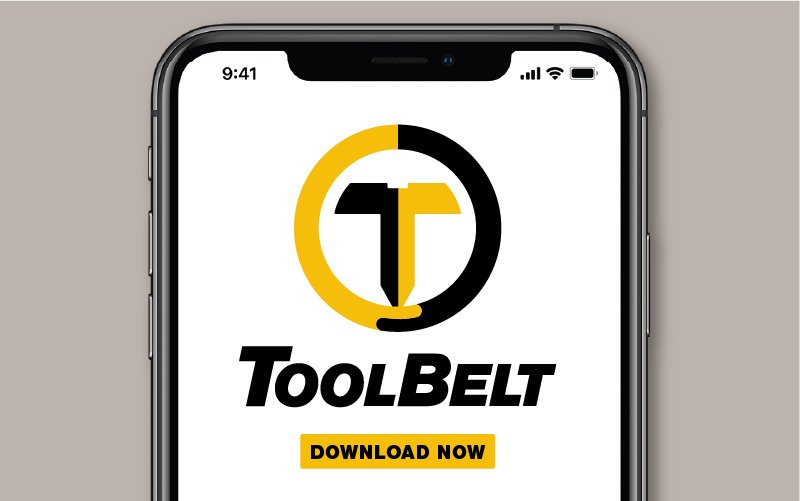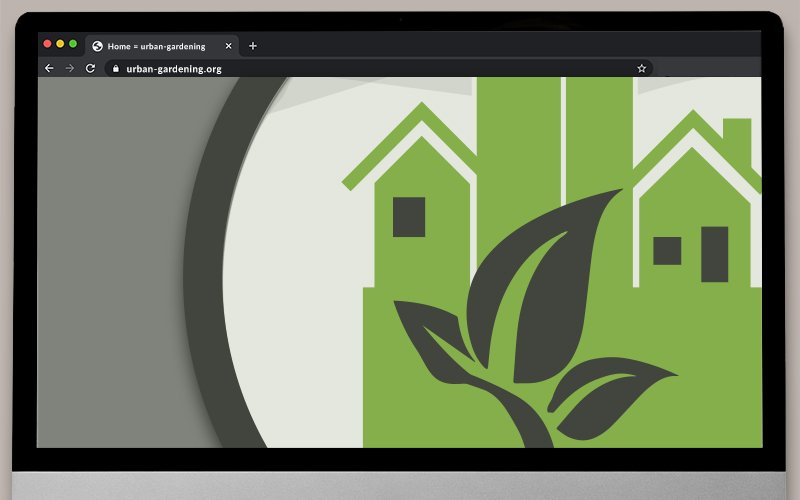Project Overview
Link: mwai.edu
The Middle Way Acupuncture Institute (MWAI) is a nationally accredited acupuncture school in Washington State, offering weekend-intensive programs in Five Element and Classical Chinese Medicine. Their audience includes working professionals, career changers, and wellness practitioners who are seeking flexible pathways to licensure.
Scope
Working with Pixels & Pines, I led the UX strategy, design, and comprehensive digital marketing planning to reimagine MWAI's website from the ground up. The project encompassed information architecture, design system development, content strategy, SEO optimization, and a phased roadmap for ongoing growth and development.
Photography & Visual Assets
To ensure an authentic visual representation of MWAI's campus and community, I art-directed on-site photography sessions conducted by the owner of Pixels & Pines. These sessions focused on capturing key campus spaces and facilities. This original photography was supplemented with carefully selected stock images to enhance the visual library.
The photography showcased:
- Campus and facility spaces (exteriors, library, treatment rooms, herbal room, front desk).
- The campus environment and architectural details.
- Key areas that prospective students would be interested in seeing.
Through strategic art direction, I ensured that the photography aligned with the website's visual identity and effectively communicated MWAI's welcoming and professional atmosphere. The combination of authentic campus photography and professional stock images created a cohesive visual narrative, helping prospective students envision themselves at MWAI while maintaining a polished aesthetic throughout the site.
Problem Statement
The Challenge
MWAI's existing website was outdated, difficult to navigate, and did not effectively reflect the school's evolving mission or engage prospective students. Key issues included:
- Disorganized site structure with unclear user flows for prospective students, alumni, and continuing education attendees.
- No centralized design system or consistent brand application across the digital presence.
- Limited SEO visibility for critical search terms like "acupuncture schools in Washington."
- An underperforming mobile experience that created barriers for the majority of prospective students.
- Poor readability and accessibility with centered text throughout, insufficient contrast ratios on dark backgrounds, and typography that didn't meet WCAG standards.
- Manual, email-based processes for admissions and continuing education registration.
- Lack of clear competitive positioning and documented value propositions.
This situation resulted in several business problems: difficulty attracting qualified prospective students, extended enrollment cycles, increased administrative burden, and missed opportunities to showcase the school's unique strengths in flexible learning and small class sizes.
Research & Discovery
Methods Used
- Stakeholder Interviews: Conducted in-depth conversations to understand enrollment pain points, identify manual process bottlenecks, and uncover gaps in the current digital presence.
- Stakeholder Kickoff Survey: Gathered input from MWAI leadership on website design priorities, competitive inspiration, current site challenges, and desired features and functionality.
- Student Survey: Distributed survey to current MWAI students to understand how they discovered the school, their decision-making process, and what information would have been helpful during their research phase.
- Competitive Analysis: Researched competitor websites to identify MWAI's unique value propositions and market positioning opportunities.
- Content Audit: Evaluated existing content to identify gaps, redundancies, and opportunities for improved clarity.
- User Journey Mapping: Mapped pathways for prospective students, alumni, and continuing education attendees to identify friction points.
Key Insights & Findings
Through this research, I documented several critical insights about MWAI's strengths and the prospective student pain points we needed to address:
MWAI's Competitive Advantages
- Flexible Learning Model: Monthly weekend-intensive format (Thursday-Sunday) allows students to continue working while pursuing education.
- Small Class Sizes: Student-to-teacher ratios of 4:1 to 14:1 provide personalized attention and hands-on training.
- Comprehensive Clinical Training: Over 500 hours of clinical experience through community clinics.
- Multiple Acupuncture Styles: Integration of Five-Element, TCM, and Japanese Meridian Therapy traditions.
- Affordable Tuition: Three-year program totaling $61,992 with flexible six-year payment plans.
User Personas
Based on stakeholder interviews and target audience research, I developed two primary personas representing MWAI's ideal students:
Persona 1: Rebecca Thompson, 34 - The Purpose-Driven Career Changer
Background: Working professional (massage therapist, nurse, yoga instructor, corporate burnout) seeking meaningful, fulfilling work with work-life balance.
Demographics: Ages 25-50, predominantly female (70%), Bachelor's degree or higher, income $40K-$90K, located primarily in Washington State.
Pain Points:
- Career dissatisfaction and burnout in the current role.
- Time constraints require a flexible education format.
- Financial concerns about student loan debt.
- Fear of failure in launching their own practice.
- Need for a supportive community of like-minded practitioners.
Goals: Become a licensed acupuncturist, achieve financial independence, make a difference through holistic healing, and integrate acupuncture into wellness practice.
Decision-Making: Research-oriented, 3-12 month timeline, values testimonials and accreditation, seeks transparent pricing and flexible payment options.
Persona 2: Sophia Ramirez, 37 - The Wellness Entrepreneur Expanding Her Practice
Background: Established wellness professional (LMT, yoga instructor, holistic health coach) looking to expand service offerings and reduce physical strain.
Demographics: Ages 28-50, predominantly female (75%), certification or Bachelor's degree in wellness, income $40K-$85K, self-employed or part-time practitioners.
Pain Points:
- Physical burnout from hands-on wellness work.
- Cannot afford to stop working to pursue a full-time degree.
- Worried about tuition costs and return on investment.
- Lack of knowledge about business integration and licensing.
- Need for cost-effective ways to expand existing practice.
Goals: Enhance existing practice with acupuncture, increase financial stability, reduce physical labor demands, and find mentorship and hands-on training.
Decision-Making: Fact-driven but emotional, 3-12 month timeline, seeks career success stories from similar professionals, attends webinars before applying.
Validating the Personas
These personas were validated through direct student survey responses, which confirmed that prospective students primarily discover MWAI through search engines, word of mouth, and the website, and that their key decision factors align with MWAI's core strengths: flexible learning format, hands-on clinical training, and affordability. The stakeholder kickoff survey further validated these insights by identifying website design priorities and confirming the challenges prospective students face during the enrollment journey.
Strategic Opportunity
The research revealed that MWAI had strong differentiators but was failing to communicate them effectively online. Both personas shared common needs, flexible learning, hands-on experience, affordable costs, and a supportive community, which directly aligned with MWAI's strengths. The website needed to bridge the gap between the school's unique value proposition and prospective students' concerns about flexible learning, clinical experience, and career outcomes.
Our Approach
Based on the research findings, I developed a comprehensive strategy that addressed both immediate website needs and long-term digital marketing growth. The approach focused on three core pillars:
Goals & Success Metrics
To ensure measurable impact, I established clear KPIs aligned with MWAI's business objectives:
- 15% increase in website traffic within 6 months.
- 10% boost in prospective student inquiries through organic lead generation.
- 10% increase in student clinic appointments through local SEO and content marketing.
1. UX Strategy & Information Architecture
- Mapped new navigation structure for three primary audiences: prospective students, alumni, and CE attendees.
- Created clear pathways to conversion with dedicated landing pages for Admissions, Continuing Education, and Clinic services.
- Developed wireframes emphasizing clarity, accessibility, and responsive behavior across all devices.
- Restructured content hierarchy to address prospective student concerns upfront (flexibility, clinical training, affordability).
2. Design System & Visual Identity
- Developed a modular design system with defined brand colors, typography, and spacin.g
- Created a Figma library with reusable components and documentation for scalability.
- Designed mobile-first layouts that prioritized the 50%+ of users accessing the site on mobile devices.
- Collaborated with the developer to implement the design using custom Spectra block patterns in WordPress.
3. Content Strategy & SEO Optimization
- Rewrote program descriptions and admissions pathways with clear, conversion-focused language.
- Created trust-building content emphasizing accreditations, faculty expertise, and student success stories.
- Implemented comprehensive keyword optimization targeting terms like "acupuncture school in Washington" and "Master of Acupuncture program."
- Enhanced local SEO with Google My Business optimization and location-specific content.
- Improved metadata and page hierarchy for search visibility.
Design Process
Phase 1: Foundation & Launch
I focused on creating a solid foundation that would solve the immediate usability and visibility problems while setting up MWAI for long-term success.
Strategic Site Mapping
- Developed a clear information architecture with dedicated sections for Programs, Admissions, Clinic, and Continuing Education.
- Created conversion-focused pathways with strategic placement of CTAs and information request forms.
- Organized content to answer prospective student questions in a logical progression.
Design System Development
- Established comprehensive brand guidelines, including color palette, typography system, and spacing rules.
- Created reusable Figma components with clear documentation for future scalability.
- Designed responsive patterns that maintained visual consistency across all breakpoints.
- Built a component library in WordPress using Spectra blocks for easy content management.
Content Creation & Optimization
- Wrote SEO-optimized landing pages that balanced search visibility with user-focused messaging.
- Created compelling program descriptions that highlighted MWAI's unique benefits.
- Developed clear calls-to-action throughout the site to drive applications and inquiries.
- Integrated social proof through student testimonials and success metrics.
Phase 2 & 3: Growth Strategy
Beyond the initial website launch, I created a comprehensive roadmap for ongoing digital marketing improvements:
Phase 2: Lead Generation
- Downloadable MAc program guides as lead magnets.
- Automated email marketing funnels for prospective students.
- Blog content strategy with SEO-focused topics.
- Social media video strategy.
- Google and social media advertising campaigns.
Phase 3: Advanced Engagement
- Virtual campus tour implementation.
- Webinars and live Q&A events.
- Online clinic scheduling with Acusimple integration.
- Alumni network and community engagement features.
- Advanced analytics and conversion tracking.
Marketing Deliverables
In addition to the website strategy, I created tangible marketing assets to support MWAI's enrollment efforts:
- Designed a professional marketing flyer for the Master of Acupuncture (MAc) program.
- Developed email marketing templates for prospective student nurture sequences.
- Created social media content guidelines and post templates.
- Documented best practices for conversion optimization and A/B testing.
Solution & Results
Launch Performance
The new website launched with an immediate, measurable impact on MWAI's digital presence and user engagement. Not only did we meet our established KPIs, but we also exceeded them.
35%
Increase in unique visits
47%
Increase in home page visits
167%
Increase in MAc program interest
Exceeding Our Goals
The results demonstrated that our strategic approach not only met but surpassed the original 6-month targets:
- Website Traffic → 35% Increase Achieved: More than doubled the target in unique visits, validating our SEO strategy and content optimization.
- Program Interest → 167% Growth: User interest increased for the MAc program, indicating strong interest from our target personas (career changers and wellness professionals).
- Overall Engagement → 47% Home Page Growth: Demonstrating improved discoverability and brand awareness.
- Conversion Performance → 4% Increase: Showing that the new UX design and clear CTAs successfully moved visitors toward applications and inquiries.
- SEO Excellence → 100% Site Score: Establishing a strong foundation for ongoing organic growth.
Qualitative Impact
- Improved Clarity: Prospective students could easily understand program options, requirements, and pathways to licensure.
- Enhanced User Flow: Clear navigation to key decision-making pages (Admissions, CE, Clinic) reduced friction in the enrollment journey.
- Brand Consistency: Cohesive visual identity across all pages reinforced MWAI's professionalism and credibility.
- Scalable Foundation: Modular design system and documented components enabled the MWAI team to maintain and expand the site efficiently.
- Strategic Roadmap: A three-phase implementation plan provided clear direction for ongoing digital marketing growth.
Long-Term Strategic Benefits
- Established a foundation for data-driven decision making with analytics-ready tracking.
- Created a self-service resource that reduced dependency on external support.
- Positioned MWAI competitively in the acupuncture education market.
- Enabled future marketing initiatives through documented strategy and assets.
- Provided a clear framework for measuring ROI on digital marketing investments.
Key Deliverables
This project resulted in comprehensive strategic and design deliverables that support MWAI's digital presence today and provide a roadmap for future growth.
Strategy & Research
- Competitive Analysis Report: Documented MWAI's key benefits, features, and market positioning relative to competitors.
- Student Survey Results: Analyzed current student responses on discovery channels, decision-making factors, and information needs.
- Stakeholder Kickoff Survey Results: Documented leadership priorities for design, functionality, and competitive positioning.
- User Personas: Detailed profiles of two primary audience segments (purpose-driven career changers and wellness entrepreneurs) with demographics, pain points, goals, and decision-making behaviors.
- User Journey Maps: Mapped pathways for prospective students, alumni, and CE attendees.
- Digital Marketing Plan: Comprehensive cost-effective strategy including timeline, deliverables, and phased approach for organic growth.
- Phased Implementation Roadmap: Three-phase plan detailing website improvements, lead generation strategies, and advanced engagement tactics.
- SEO Strategy Document: Keyword research, metadata templates, and ongoing content recommendations.
Design System & Website
- Figma Design Library: Complete component library with reusable blocks, style guide, and documentation.
- Responsive Website: WordPress site built with custom Spectra block patterns and Astra Pro theme.
- Mobile-First Layouts: Optimized designs tested across all device sizes.
- Brand Guidelines: Comprehensive documentation of colors, typography, spacing, and visual identity.
Marketing & Content
- MAc Program Flyer: Professional marketing collateral for program promotion.
- Social Media Strategy & Templates: Guidance for Instagram, Facebook, and LinkedIn with post templates focusing on student testimonials, educational content, campus life, and clinic promotions.
- Blog Content Strategy: Monthly blog post topics and templates optimized for SEO (e.g., "How to Become an Acupuncturist," "5 Myths About Acupuncture").
- Email Marketing Framework: Quarterly newsletter templates for prospective students, current students, and clinic promotions with automated nurture sequences.
- Lead Generation Framework: Downloadable resources, form designs, and conversion pathways.
- Local SEO Guidance: Google My Business optimization strategy and review generation recommendations.
- Conversion Optimization Guide: Best practices for CTAs, landing pages, and A/B testing.
Training & Documentation
- WordPress Training: Documentation and guidance for MWAI's internal team.
- SEO Best Practices: Ongoing recommendations for maintaining and improving search visibility.
- Analytics Setup: Google Analytics and Microsoft Clarity implementation with custom event tracking.
Reflection & Learnings
What Worked Well
- Research-Driven Approach: The competitive analysis, stakeholder interviews, student survey, and stakeholder kickoff survey provided crucial insights that shaped the entire strategy. Creating two distinct personas allowed us to craft messaging that resonated with both segments while highlighting MWAI's unique value proposition (flexible learning, small class sizes, comprehensive clinical training). The student survey validated that prospective students typically discover MWAI through search engines and word of mouth, confirming our focus on SEO and content strategy.
- Holistic Strategy: By combining UX design, SEO, content strategy, and digital marketing planning, we created a cohesive solution that addressed both immediate needs and long-term growth, demonstrating that technical excellence and user experience work in harmony.
- Scalable Design System: Creating a modular Figma library with reusable components enabled the team to maintain consistency across the site.
- Phased Implementation: The three-phase roadmap gave MWAI a realistic, prioritized path forward that made recommendations actionable rather than overwhelming.
Challenges Faced & How I Overcame Them
- Limited Existing Analytics: MWAI didn't have comprehensive data on previous website performance. I addressed this by implementing robust tracking from the outset and setting clear benchmarks for measuring future success. The early engagement metrics (71% scroll depth, 2.7 pages/session) validated our UX decisions and established a baseline for future optimization.
- Multiple Audience Segments: Designing for prospective students, alumni, and CE attendees required careful information architecture planning. I solved this by creating clear navigation paths and dedicated landing pages for each audience, ensuring everyone could quickly find the relevant information. This taught me the value of audience-first sitemap planning rather than organization-first structure.
- Technical Constraints: Working within WordPress and the Spectra/Astra Pro ecosystem required balancing ideal design with platform capabilities. I collaborated closely with the developer to find creative solutions that achieved our UX goals while remaining technically feasible and maintainable.
- Manual Process Dependencies: Many of MWAI's enrollment and CE registration processes were email-based. While we couldn't resolve all process issues in Phase 1, I documented opportunities for future automation and integration (such as Acusimple software for clinic scheduling) in the phased roadmap. This demonstrated the importance of acknowledging process gaps honestly rather than over-promising immediate fixes.
What I Would Do Differently
- Usability Testing During Design Phase: While we surveyed current MWAI students to understand their enrollment journey and validated our personas with real user feedback, conducting moderated usability testing sessions with prospective students during the wireframing and design phases would have provided even more granular insights into navigation patterns and information hierarchy preferences. Recruiting a small group of career changers and wellness professionals for concept testing would have caught any friction points earlier in the process.
- More Granular Analytics Planning: While we implemented Google Analytics and Clarity, I would establish more detailed conversion tracking and event monitoring from day one to better measure specific user behaviors tied to our KPIs (form submissions, video views, program page visits by persona type).
- Documented Content Calendar: Beyond the content strategy templates and blog guidance, creating a specific 3-6 month content calendar with scheduled blog topics, social media themes, and email campaigns would have given MWAI's team even more concrete guidance for Phase 2 implementation.
Key Strategic Insights
- Persona-Driven Design Creates Focus: Developing detailed personas provided a north star for all decisions. Rather than trying to appeal to everyone, we could craft specific messaging that addressed the persona's unique pain points while highlighting shared benefits, proving that strategic focus outperforms generic approaches.
- Competitive Research Reveals Differentiation: A thorough competitive analysis prevents generic messaging and reveals authentic differentiators that are worth emphasizing. Understanding what competitors offer helps position a brand's genuine strengths rather than relying on assumptions.
- Design Systems Are Strategic Investments: The upfront investment in a comprehensive Figma library and WordPress component system created lasting value, reducing long-term costs and dependency.
- Implementation Requires Realistic Roadmaps: The three-phase approach made recommendations actionable by providing a realistic, prioritized implementation path.
- UX and SEO Must Work Together: Creating user-friendly navigation while optimizing for search engines requires a careful balance. Success came from structuring content to satisfy both algorithms and humans' information needs, creating compound benefits that neither discipline achieves alone.
- Early Wins Build Momentum: Setting clear and measurable goals at the beginning of the project ensured accountability and helped showcase the return on investment.
Impact on My Practice
This project reinforced the value of combining UX strategy, visual design, content strategy, and digital marketing planning into a holistic approach. By addressing the entire digital ecosystem rather than just the website interface, I was able to create more sustainable and strategic value for MWAI, providing ongoing strategic direction beyond the initial launch.
"This project allowed us to fully apply our UX and systems thinking for a values-driven client. MWAI's strong connections to nature and tradition inspired a clean and grounded design, merging modern usability with timeless storytelling."
– Pixels & Pines



